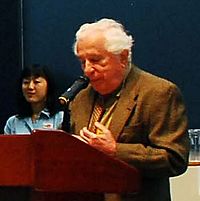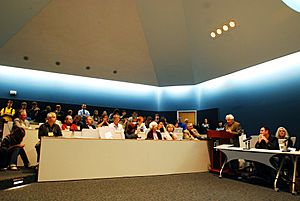Seymour Topping facts for kids
Quick facts for kids
Seymour Topping
|
|
|---|---|

Topping at the Reynolds Journalism Institute (2008)
|
|
| Born | Seymour Topolsky December 11, 1921 New York City, New York, U.S. |
| Died | November 8, 2020 (aged 98) White Plains, New York, U.S. |
| Occupation | Journalist, author, and professor |
| Language | English |
| Alma mater | University of Missouri School of Journalism |
| Notable works | On the Front Lines of the Cold War Journey Between Two Chinas |
| Spouse |
Audrey Ronning
(m. 1948) |
| Children | 5 |
Seymour Topping (December 11, 1921 – November 8, 2020) was an American journalist. He was famous for reporting from many countries. He covered wars in places like China, Korea, and Vietnam. He also reported on the Cold War in Europe.
From 1969 to 1986, he held a very important job at The New York Times newspaper. Later, he taught journalism at Columbia University. He also helped manage the Pulitzer Prizes, which are major awards for journalism and arts.
Contents
Early Life and Education
Seymour Topping was born as Seymour Topolsky on December 11, 1921. He was born in Harlem, a part of New York City. His parents, Joseph and Anna, were immigrants from Russia.
He grew up in Queens and The Bronx. In 1939, he finished high school at Evander Childs Educational Campus. After that, he studied journalism at the University of Missouri School of Journalism. He earned his degree in 1943.
A Career in Journalism
Seymour Topping had an exciting career that took him all over the world. He started as a soldier and then became a journalist.
Serving in World War II
Topping was part of the Reserve Officers' Training Corps. This program trains college students to become officers. He served as an infantry officer in the United States Army. He fought in the Philippines during World War II.
Reporting from War Zones
After the war, Topping became a journalist. He joined the International News Service in Manila. They sent him to China to report on the civil war happening there. A civil war is a war between different groups within the same country.
In 1948, he started working for the Associated Press. He was a foreign correspondent in China and Southeast Asia. A foreign correspondent is a reporter who lives in another country to cover news there.
- In 1949, he was covering the civil war in Nanjing, China.
- He was captured by the communist forces.
- He was released when the nationalist forces gave up.
In the 1950s, Topping reported on the Korean War. He was also the first American reporter in Vietnam since World War II. There, he covered the French colonial war. This was a fight between French forces and communist forces led by Ho Chi Minh.
Working at The New York Times
Topping joined The New York Times in 1959. He worked there for 34 years. He had many different jobs at the newspaper:
- He was a reporter in New York City.
- He was the head of the Moscow and Southeast Asia news offices.
- He became the foreign editor.
- From 1969 to 1986, he was a very important editor. He worked closely with the top editor, A. M. Rosenthal.
- They helped the newspaper become very successful. They added new sections and magazines.
In 1987, Topping became the director of editorial development for The New York Times Company. His job was to make sure the other newspapers owned by the company had good journalism.
Major Events Covered
Topping reported on many big events around the world:
- As the Moscow bureau chief, he covered the 1960 U-2 incident. This was when a U.S. spy plane was shot down over the Soviet Union.
- He reported on the Sino-Soviet split. This was a disagreement between China and the Soviet Union.
- He also covered the Soviet space program and the Cuban Missile Crisis in 1962. The Cuban Missile Crisis was a very tense time when the U.S. and the Soviet Union were close to war.
Later, as the Southeast Asian bureau chief, he covered the Vietnam War. He also reported on the civil wars in Laos and Cambodia.
Pulitzer Prizes and Teaching
In 1993, Topping left The New York Times. He joined the Pulitzer Prize Board. He was the secretary and administrator of the Pulitzer Prizes until 2002. These awards honor the best in American journalism, literature, and music.
From 1994 to 2002, he also taught journalism. He was a professor at the Columbia University Graduate School of Journalism.
Many people respected Topping's work. Fellow journalists called him "one of the most accomplished foreign correspondents of his generation."
Personal Life
Seymour Topping married Audrey Ronning on November 10, 1948. Audrey was a photojournalist, a filmmaker, and an author. Her father was a Canadian diplomat named Chester Ronning.
Seymour and Audrey had five children together. They lived in Scarsdale, New York, from 1967 until Seymour's death. Sadly, one of their daughters, Susan, passed away in 2015.
Seymour Topping died on November 8, 2020. He was 98 years old. He passed away in White Plains, New York, after having a stroke.
Books by Seymour Topping
Seymour Topping was also an author. He wrote several books, including:
- On the Front Lines of the Cold War: An American Correspondent's Journal from the Chinese Civil War to the Cuban Missile Crisis and Vietnam (2010). This book shares his experiences reporting on major world events.
- Journey Between Two Chinas (1972).
- The Peking Letter: A Novel of the Chinese Civil War (1999). This is a novel, which means it's a fictional story.
- Fatal Crossroads: A Novel of Vietnam 1945 (2005). This novel was partly based on real experiences.
Articles written by Topping and his wife were also included in a book called The New York Times Report from Red China (1971).


